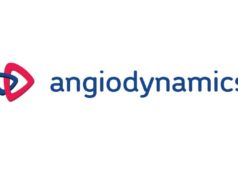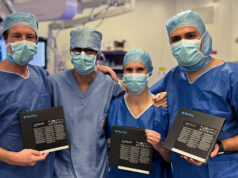
Supported by a world-class faculty, this year’s meeting brings together the leading vascular and endovascular specialists from around the globe to cover all the relevant interventional/imaging/endovascular topics right through to the latest techniques, clinical results and device updates.
The concept by previous Charing Cross meetings has been to focus exclusively on vascular and endovascular topics for the first two days of the meetings, as part of the ‘Global Endovascular Forum’, and the remaining two days would look at the optimal imaging, vascular and endovascular methods of treating vascular disease.
Challenges
At this year’s meeting the entire four days of the conference will identify the ‘Challenges’ that arose from the 2006 ‘Controversies’ meeting, and discuss the best treatments and methods available for treating vascular disease, lesion by lesion. Each new session under discussion will witness a speaker introduce the subject, also discussed in the 29th Edition of the Charing Cross Symposium book, ‘Vascular and Endovascular Challenges’, and the audience will then hear the latest evidence from subsequent speakers, and are encouraged to take part in the ensuing debate.
EVAR and patient fitness takes centre stage at CX
The question of patient fitness and suitability for endovascular aneurysm repair (EVAR) was first raised by Professor Janet Powell, London, UK, when after seeing the results from the EVAR 2 trial she commented, “If the patient is high risk, the emphasis should be to get the patient fit enough first rather than perform early EVAR.” Ever since, a debate has been raging as to the importance of a patients’ fitness – Louise Brown, London, UK, will attempt to answer this and other questions as she discusses the relevance of fitness and high risk in relation to the EVAR Trials results.
There will also be an update on the cost-effectiveness of EVAR by Dr Jonathan Michaels, Sheffield, UK, later on Tuesday morning. Dr Vicente Riambau, Barcelona, Spain, will then discuss the ‘Economic impact of EVAR in a university hospital: a matching study’. Given the impact the Belgian Health and Technology Assessment (HTA) report had on EVAR in that country and the continued cost of surveillance, this will be a fascinating session that promises to evoke more debate and discussion.
Although there is a distinction between those patients involved in the EVAR 2 Trial, who were deemed ‘unfit’ for surgery and those patients involved in the Society of Vascular Surgery’s (SVS) Lifeline Registry who were ‘high risk’, Dr Gregorio Sicard, past-President of the SVS will discuss the Registry’s results and note that the data are encouraging for the proponents of endovascular aneurysm repair. Additional US data to be presented includes an evaluation of data from centres for Medicare and Medicaid services (President-SVS, Dr Craig Kent, New York, USA); EVAR in high-risk patients – results from the VA National Surgical Quality Improvement Program (Dr Alan Lumsden, Houston, USA); and a single-centre EVAR experience from Cleveland Clinic (Dr Roy Greenberg, Cleveland, USA). These data all demonstrate the progress EVAR has made in terms of mortality outcomes. Similarly, a presentation by Professor Dieter Raithel, Nuremburg, Germany, will highlight the reduction of serious adverse events following the EVAR.
Ruptured AAAs and EVAR complications
There are limited data regarding emergency EVAR for ruptured abdominal aortic aneurysms (AAA) (the New ERA Study, the Nottingham series and New York data) and two presentations (Dr Frank Veith, New York, USA, and Dr Jaap Buth, Eindhoven, The Netherlands) will attempt to explain the variability of the results. They will be followed by Dr Eric Verhoeven, Groningen, The Netherlands, who will report on the results of acute aneurysm surgery in the modern era (2003-2006).
Mr Rob Sayers, Leicester, UK, and Professor Jesper Swedenborg, Stockholm, Sweden, will then discuss the complications of internal iliac artery embolisation prior to endovascular aneurysm repair and the site of rupture and bleeding into the thrombus in infra-renal aortic aneurysms, respectively.Global Endovascular Forum
The first session of the symposium will highlight ‘Miscellaneous vascular and endovascular challenges.’ Chaired by Professor Tony Watkinson, Exeter, Devon, UK, the symposium will begin with Dr Lars Norgren, Orebro, Sweden, who will present an examination of the Inter-Society Consensus for the Management of Peripheral Arterial Disease, discussing TASC II. Professor David Bergqvist, Uppsala, Sweden, who will assess the strengths and weaknesses of national registries and randomised trials, will follow him.
Incorporating the ‘Global Endovascular Forum’, the session will then move on to discuss new techniques, technologies and horizons, with Professor Willem Wisselink, Amsterdam, The Netherlands, examining the value of robotics in vascular surgery, Professor Reto Bale, Innsbruck, Austria, who will highlight image fusion and 3D navigation in interventional radiology, and Professor Mehmet Kurtoglu, Istanbul, Turkey, who will analyse the role of diagnostic ultrasound in arterial injury.
Following two presentations on acute and chronic bowel ischaemia from Mr Trevor Cleveland, Sheffield, UK, and Dr Martin Bjorck, Uppsala, Sweden, the session will then examine the role of embolic protection devices in renal artery intervention, from Dr Jon Moss, Glasgow, UK, and look at new and future embolic protection devices and techniques, by Professor Jafar Golzarian, Iowa, USA.
Training vascular specialists
As ever, the issue of training the vascular specialists of the future remains a contentious issue and at this year’s meeting delegates will hear from vascular and interventional radiologists on the joint vascular training programme recently agreed between the Vascular Society and the British Society of Interventional Radiology. In addition, there will also be presentations asking whether vascular access is good training for the vascular trainee and a look at the role of simulators in developing technical skills.
At this year’s symposium there will all be a dedicated session on both surgical and endovascular management of the diabetic foot with by presentations and discussions from Professor Iris Baumgartner, Bern, Switzerland, and Professor Mauri Lepantalo, Helsinki, Finland. In addition, Dr Thomas McNamara, Los Angeles, CA, will highlight new techniques for the diabetic foot.
Lower limb
The next session will concentrate on the lower limb. As well as examining the level of evidence for stenting and updates from the RESILIENT and ZILVER PTX trials (see page 8), there will also be a critical analysis of the problems associated with stent fractures and the importance of stent design and stent selection, by Dr Dierk Scheinert, Leipzig, Germany. Delegates will then see two presentations that consider new devices for the lower limb such as lasers, atherectomy and cryoplasty. Cryoplasty that combines conventional balloon angioplasty with a proprietary cryogenic programme is designed to revascularise an artery while simultaneously treating it to inhibit restenosis, has had limited success and Dr David Kessel, Leeds, UK, will assess the evidence so far.
The audience will also hear new developments in stem cell therapy for the treatment of critical limb ischaemia from Dr Ralf Kolvenbach, Dusseldorf, Germany, as well as the 12-month results from the FAST trial. There will also be discussions on management of popliteal aneurysms from SVS past-President, Dr Enrico Ascher, New York, as well as an overview of a randomised trial between remote endarterectomy and bypass surgery from Dr Jean Paul de Vries, Utrecht, The Netherlands.
Small aneurysms and surveillance
On Sunday there will be an overview of two the small AAA trials, PIVOTAL and CAESAR, and the audience will then hear from Professor Janet Powell, London, UK, who will present 12-year follow-up from the UK Small Aneurysm Trial on behalf of the trial participants. The results of the trial, previously reported in Vascular News, confirmed the effectiveness of surveillance vs. early intervention. Therefore, it is appropriate that the next speaker will be Mr Alan Scott, Chichester, UK, who will discuss the UK screening programme for abdominal aortic aneurysm, based upon intervention at 5.5cm.
Thoracic
As well as the latest trial results and additional discussions on thoracic dissection and aneurysms (see page 6), there will also be a session dedicated to thoracic trauma (Dr Hence Verhagen, Utrecht, The Netherlands), aortic arch repair (Professor Jean-Pierre Becquemin, Paris, France) and neurological complications (Dr Frank Criado, President-ISES, Baltimore, USA). In addition, Dr Ross Milner, Atlanta, USA, discuss his experience with the CardioMEMS pressure sensor during endovascular thoracic aortic aneurysm (TAA) repair. The CardioMEMS is a non-invasive, sac pressurement system that measures aneurysm sac pressure wirelessly using radiofrequency energy and proprietary measurement technology.
Carotid disease and stroke prevention
In addition to numerous updates from carotid trials (see page 10), the symposium will also highlight the most prevalent issues surrounding carotid disease and stroke prevention. Professor Charles McCollum, Manchester, UK, will begin the presentations by discussing paradoxical embolism and its role in acute stroke in young adults and will be followed by Mr Peter Lamont, Bristol, UK, who will present ‘Early surgery or delayed intervention for minor stroke?’
Next, Mr Geoffrey Gilling-Smith Liverpool, UK, will ask whether it is possible to identify asymptomatic patients who will benefit from intervention, the relevance of which will not be missed on those physicians participating in the asymptomatic carotid trials (such as ACST-2). Dr Gunnar Tepe, Tuebingen, Germany, will then analyse the use of drug-eluting stents in the treatment of carotid disease and their usefulness in preventing restenosis in follow-up. Jon Matsumura, Chicago, USA, will also examine the issue of restenosis in a presentation entitled, ‘Durability of carotid stenting: long-term patency data and in-stent restenosis management’.
Next, Ascher will discuss the relative merits of ultrasound-guided carotid stenting and he will be followed by Dr Mark Wholey, Pittsburgh, USA, who will present data looking at the role of carotid stenting in octogenarians: asymptomatic and symptomatic.
Before the presentation from several carotid trial trials, Dr Sumaira Macdonald, Newcastle-upon-Tyne, UK, will appraise the cost-effectiveness of carotid stenting before Dr Patrick Peeters, Bonheiden, Belgium, looks at how controlled randomised trials have affected the reimbursement procedure for carotid artery stenting in Belgium.
Once again, delegates will be asked to consider the impact and weight of the speaker’s arguments and vote on the debates. As was witnessed during the 2006 meeting, the voting system proved to be popular and, more often than not, revealed interesting and surprising results. Given the topics under discussion at this year’s meeting we are sure to see more of the same.












